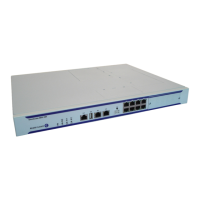VPLS Packet Walkthrough
Page 328 7750 SR OS Services Guide
table that associates the MAC address to the service access point (SAP) on which it was
received.
c. The destination MAC address in the packet is looked up in the FIB table for the VPLS in-
stance. There are two possibilities: either the destination MAC address has already been
learned (known MAC address) or the destination MAC address is not yet learned (unknown
MAC address).
For a Known MAC Address (Figure 36):
d. If the destination MAC address has already been learned by PE-Router-A, an existing entry
in the FIB table identifies the far-end PE-Router and the service VC-label (inner label) to
be used before sending the packet to far-end PE-Router-C.
e. PE-Router-A chooses a transport LSP to send the customer packets to PE-Router-C. The
customer packet is sent on this LSP once the IEEE 802.1Q tag is stripped and the service
VC-label (inner label) and the transport label (outer label) are added to the packet.
For an Unknown MAC Address (Figure 36):
f. If the destination MAC address has not been learned, PE-Router-A will flood the packet to
both PE-Router-B and PE-Router-C that are participating in the service by using the VC-
labels that each PE-Router previously signaled for the VPLS instance. Note that the packet
is not sent to PE-Router-D since this VPLS service does not exist on that PE-Router.
Figure 4: Network Port Egress Packet Format and Flooding
B
PE C
B
Customer
Location A
IP/MPLS NETWORK
PE A
B
Pre-assigned and
signaled by PE ‘C’
PE B
Apply VC and
Tunnel Labels
Customer
Packet
Src
MAC
Dest
MAC
VC
Label X
Tunnel
Label
Customer
Packet
Src
MAC
Dest
MAC
VC
Label Y
Tunnel
Label
Pre-assigned and
signaled by PE ‘B’
B
PE C
B
Customer
Location A
IP/MPLS NETWORK
PE A
B
Pre-assigned and
signaled by PE ‘C’
PE B
Apply VC and
Tunnel Labels
Customer
Packet
Src
MAC
Dest
MAC
VC
Label X
Tunnel
Label
Customer
Packet
Src
MAC
Dest
MAC
VC
Label Y
Tunnel
Label
Pre-assigned and
signaled by PE ‘B’

